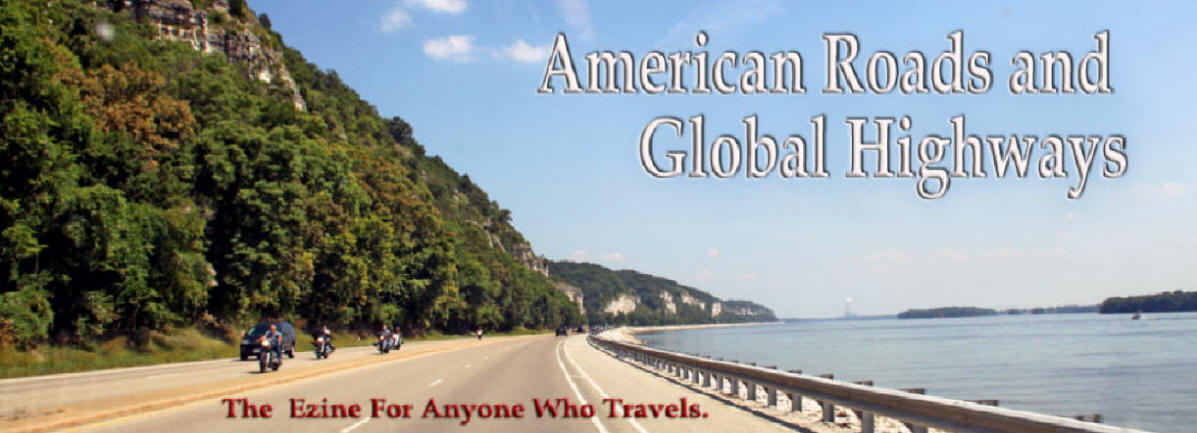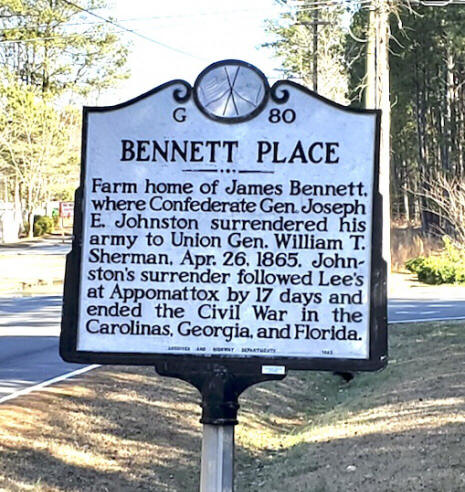
|
|
|
|
"Pentimento, in art, is the reappearance in an original
oil painting or drawing that the artist attempted to
eradicate by painting over it. If the repainting becomes
transparent ghostly images from the earlier work may
become visible to the eye." Bennett Place
People believe the Civil War ended with Lee's surrender of 26,000 troops but the war continued and General Johnston and General Sherman met at Bennett Place on April 17, 1865. They worked out surrender terms but the government felt they were too lenient and Jefferson Davis told Johnston to continue to fight. Johnston and Sherman met again on April 26th and Johnston surrendered 89,270 troops. The final surrender occurred on June 23, 1865.   Tours are offered at the 1890- acre Piedmont NC farm, Bennet Place. The site has been fully reconstructed to appear as it did in 1865. Three buildings, the farmhouse, kitchen and smokehouse interpret both the surrender and typical NC southern farm life. A museum in the Visitor Center shows an orientation film, "The Dawn of Peace", and displays numerous artifacts. The 1923 Unity Monument is on the exterior and visitors can picnic or follow several forest nature trails. Admission is free. www.bennettplacehistoricsite.com   The soldiers idled in neutral Durham from the 17th until the 26th, discovered and smoked up all the local tobacco and Durham believed it was ruined. Soon they began to receive orders for their special "bright leaf tobacco" from all over the country and a massive tobacco industry was born. The bull was selected as the trademark from a jar of Coleman's Durham Mustard and Bull Durham went down in history. Major, a 10-foot-tall bronze sculpted bull provides a photo-op in the heart of the city. discoverdurham.com Duke Homestead American Tobacco
Bert's Bees Durham is a dining destination and every
meal is a treat. The eateries are unique I suggest you
try as many as you able to. Here are 4 for the road that
offer memorable food, outstanding service and
affordability.
Amy May Pop Art. These handmade pop art treasures make
perfect gifts. You can purchase an existing piece or
have one personalized. @amymaypopart Next Week: Durham's African American Heritage Trail
Renee Gordon has written a weekly travel column for the Philadelphia Sun Newspaper for the past fifteen years and has published articles on local, national and international travel in numerous publications. Her columns focus on cultural, historic and heritage tourism and her areas of specialization are sites and attractions related to African American and African Diaspora history. Renee has been a guest radio commentator on various aspects of tourism and appeared in a documentary, "The Red Summer of 1919". As an educator for thirty years she was an English teacher, event and meeting planner, served as an educational consultant and intern-teacher mentor. She contributed to textbooks on women's history and classroom management and has facilitated workshops on both subjects. Renee considers herself a "missionary journalist" and as such she continues to promote heritage and sustainable tourism. 2013 Recipient of African Diaspora World Tourism Flame Keeper in Media Award for Travel Writing Affiliations
We'd love your comments!
|
Connect with us on:
American Roads and | ||||||
|
Public Disclosure--
Please Read The FTC has a law requiring web sites to let their readers know if any of the stories are "sponsored" or compensated. We also are to let readers know if any of our links are ads. Most are not. They are just a way to direct you to more information about the article where the link is placed. We also have several ads on our pages. They are clearly marked as ads. I think readers are smart enough to know an ad when they see one but to obey the letter of the law, I am putting this statement here to make sure everyone understands. American Roads and Global Highways may contain affiliate links or ads. Further, as their bios show, most of the feature writers are professional travel writers. As such we are frequently invited on press trips, also called fam trips. On these trips most of our lodging, dining, admissions fees and often plane fare are covered by the city or firm hosting the trip. It is an opportunity to visit places we might not otherwise be able to visit. However, no one tells us what to write about those places. All opinions are 100% those of the author of that feature column. |
|||||||
|
Privacy Policy/ Archives /
Contributors /
Subscribe to
American Roads Books by
Kathleen Walls /
Contact /
Sponsor or Advertise/ American Roads & Global Highways Home Page
|




















